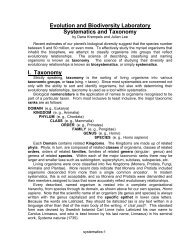Biodiversity Data Analysis: Testing Statistical Hypotheses
Biodiversity Data Analysis: Testing Statistical Hypotheses
Biodiversity Data Analysis: Testing Statistical Hypotheses
You also want an ePaper? Increase the reach of your titles
YUMPU automatically turns print PDFs into web optimized ePapers that Google loves.
It is also important to understand how much variation a group of subjects exhibits around<br />
the mean. For example, if the average human shoe size is "9," we must determine whether<br />
shoe size forms a very wide distribution (with a relatively small number of individuals wearing<br />
all sizes from 1 - 15) or one which hovers near the mean (with a relatively large number of<br />
individuals wearing sizes 7 through 10, and many fewer wearing sizes 1-6 and 11-15).<br />
Measurements of dispersion around the mean include the range, variance and standard<br />
deviation.<br />
Parameters and Statistics<br />
If you were able to measure the height of every adult male Homo sapiens who ever existed,<br />
and then calculate a mean, median, mode, range, variance and standard deviation from your<br />
measurements, those values would be known as parameters. They represent the actual<br />
values as calculated from measuring every member of a population of interest. Obviously, it is<br />
very difficult to obtain data from every member of a population of interest, and impossible of<br />
that population is theoretically infinite in size. However, one can estimate parameters by<br />
randomly sampling members of the population. Such an estimate, calculated from<br />
measurements of a subset of the entire population, is known as a statistic.<br />
In general, parameters are written as Greek symbols equivalent to the Roman symbols<br />
used to represent statistics. For example, the standard deviation for a subset of an entire<br />
population is written as "s", whereas the true population parameter is written as σ.<br />
Statistics and statistical tests are used to test whether the results of an experiment are<br />
significantly different from what is expected. What is meant by "significant?" For that matter,<br />
what is meant by "expected" results? To answer these questions, we must consider the<br />
matter of probability.<br />
II. Experimental Design for <strong>Statistical</strong> <strong>Hypotheses</strong><br />
As you know from reading Appendix I, statistical hypotheses are stated in terms of two<br />
opposing statements, the null hypothesis (H o ) and the alternative hypothesis (H a ). The null<br />
hypothesis states that there is no significant difference between two populations being<br />
compared. The alternative hypothesis may be either directional (one-tailed), stating the<br />
precise way in which the two populations will differ, or nondirectional (two-tailed), not<br />
specifying the way in which two populations will differ.<br />
For example, if you were testing the efficacy of a new drug (Fat-B-Gon ) in promoting<br />
tm)<br />
weight loss in a population of volunteer subjects, you would assemble two groups of volunteers<br />
who are as similar as possible in every aspect (age, sex, weight, health measurements, etc.),<br />
and divide them into two groups. One half of the subjects (the treatment group) would receive<br />
the drug, and the other half (the control group) would receive an inert substance, known as a<br />
placebo, that subjects cannot distinguish from the actual drug. Both groups would be<br />
administered either the drug or the placebo in exactly the same way. Subjects must not know<br />
whether they are in the treatment or control group (a single-blind study), as this will help to<br />
prevent the placebo effect, a measurable, observable change in health or behavior not<br />
attributable to a medication or other treatment. The placebo effect is believed to be triggered<br />
by a subject’s belief that a medication or treatment will have a certain result. In some cases,<br />
not even the investigators know which subjects are in the treatment and control groups (a<br />
double-blind study). Thus, the only difference between the treatment and control groups<br />
<strong>Biodiversity</strong> – <strong>Data</strong> <strong>Analysis</strong> 2

















